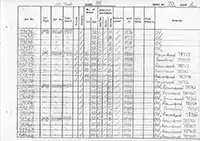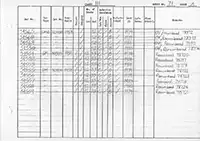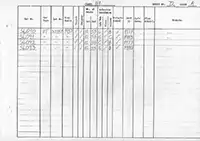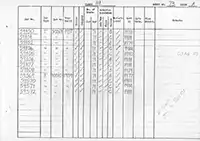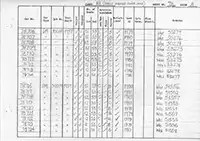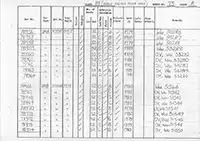Class 111 Met-Camm sets 2/3-car DMUs
Description
Power Train

The underside of a vehicle, the whitish box is the gearbox, the output shaft drives the dynamo to its right.
Power cars were powered with two Rolls Royce C6 6 cylinder engines rated at 180hp. The image is taken from underneath with the SE4 gearbox closest and an engine behind. The dynamo is in the top right, fuel tank top left.
They had mechanical transmission using SE4 Wilson epicyclic gearbox manufactured by Self Changing gears Ltd. Interestingly figures for the gear ratios of the gearboxes is different batches one and two - see the technical details in the drivers instructions, the figures for batch two match the ratios for R14 boxes.
Batch two may have originally been ordered with AEC 150hp engines and R14 gearboxes, then the details changed before delivery - see notes from the BUT Original Equipment listings.

Supercharged
One power car, M50136, which was tested with a supercharged version of the engine producing 230hp. The image shows it on trial with dynamotor vehicles.
Cabs
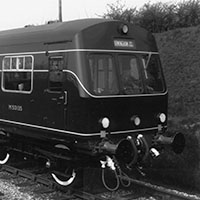
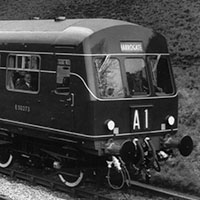
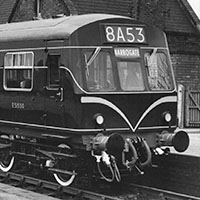
Three different cab fronts were used on this class, which would match the corresponding Class 101s being built at the time:
- The four LMR power/trailer 1957 sets had four marker lights.
- The 3-car sets built in 1957 had two marker lights and a two-character train describer panel beneath the centre cab window.
- In 1959 by the time the last 10 three-car sets were constructed (they were the last Met-Camm power cars to be delivered), the four-character headcode box was mandatory. This headcode box was located above the driving cab windows where, due to its height and width a modification to the central cab window had to be made in order to accommodate the destination blind display. This involved fitting a smaller central cab window and lowering the destination box by 6 inches into what was the window space.
After headcodes were abandoned in January 1976 these boxes were eventually removed and the space plated over, returning these vehicles to the original style though the lowered destination display remained still making identification of this batch easy.
Identification
How do you tell a 111 from a 101 if it wasn't from the last batch? The next easiest identifier is the exhaust pipes. On the Rolls Royce engines the exhaust outlet was on the right side of the engine, on the BUT engines (Leyland or AEC) it came from the left. As seen in the two example images, the first shows a 111 non-drivers side, and the exhaust seems to come from behind the radiator, the second image shows a 101 which has a notably shorter exhaust. The radiator size also differs.
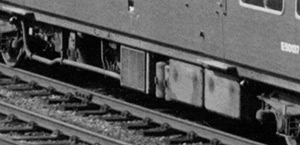
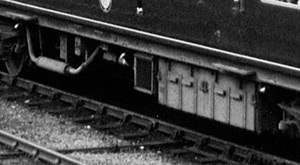
Differences in the battery box covers can also be seen, although this 111 type only seems to have been fitted to the first four sets. There also two upright cylinders between the battery boxes and radiator on a 111 - probably the air intake filters.
On the drivers side the reverse is true for the exhaust pipes, the 111s have a noticely shorter one and the radiator really seems to stand out.

Buffet Cars
It seems that the decision to have some buffet cars in batch three was made late on, when construction had already began on regular centre cars. This will be the reason the windowless area looks like filled in windows, clearly seen in the image of SC59577 at Haymarket depot in November 1977. Note the window bars on the doors. Alan Rintoul.
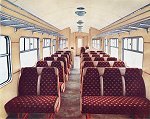
Interiors
The interiors matched the contemporary Class 101s being produced. The 1959 cars had maroon seating in second class. The image is from a Met-Camm publicity brochure - a rare colour interior photo, although probably a B&W picture that was 'colourised'.
Single engine conversions DHBS and DHS(L)
After the success of an experiment conducted by Doncaster Works on Class 104s 50446/50521 in 1982, it was decided to remove one engine and its associated equipment from the remaining Class 111 motor cars as a maintenance and cost saving measure. Centre trailers were removed where necessary and redeployed in other units, after conversion the remaining power cars were paired together as power twins with just one engine per car they had a combined 360hp, half normal power but enough for the duties they were to perform.

The image shows the gangway ends of converted vehicles, with just one exhaust on the number two side of each vehicle.
These units were operated by Neville Hill (NL) depot in Leeds, and carried "Metro Train" and South Yorkshire PTE logos.
Vehicles treated remained in the blue and grey livery but were renumbered in the 78xxx number series. The vehicles involved were all from the two later batches, none of the four early power cars were converted.
Asbestos
The vehicle were built with blue asbestos insulation in the cabs and saloon walls and ceiling. The pages below are from a vehicle log kept by the RTC at Derby dated circa 1984 which included the asbestos status for each vehicle.
The codes for the asbestos columns are: / not built with blue asbestos; B - blue asbestos; and C - removed. In the remarks column OV means open van (no cage).
Summary
Description
- LMR 2-car
- NER 3-car (earlier)
- NER 3-car (later)
Refurbishment
Drivers Instructions & Adverts
Numbering
Liveries
LMR plans
Operations
Non-Passenger Use
Images
Details about the preserved Class 111 vehicle can be found here.



